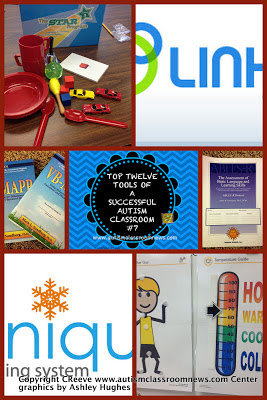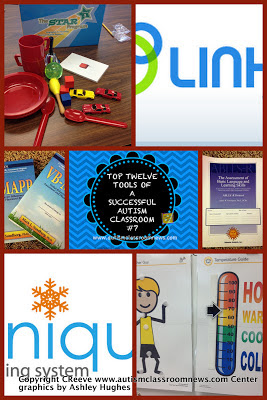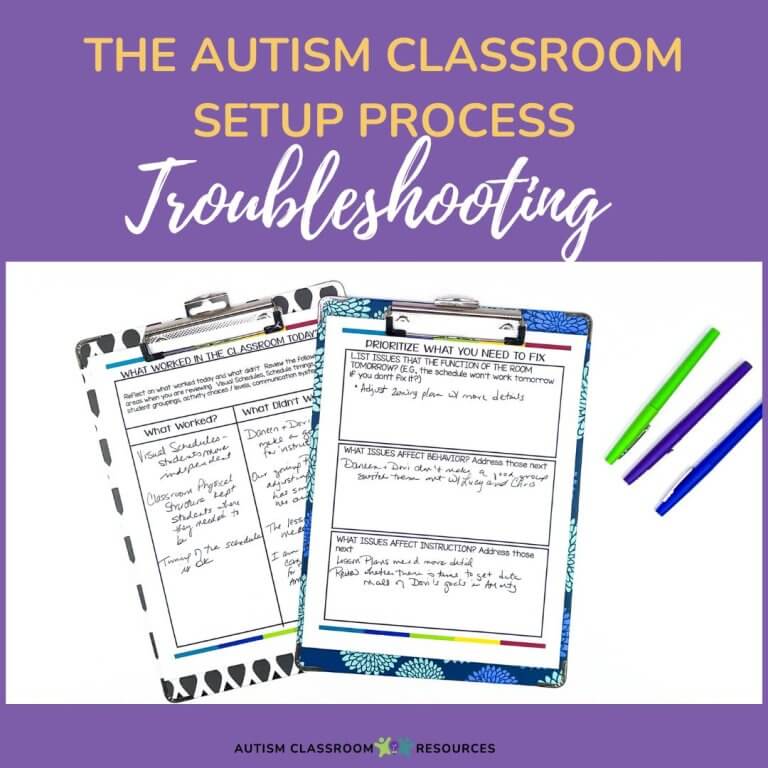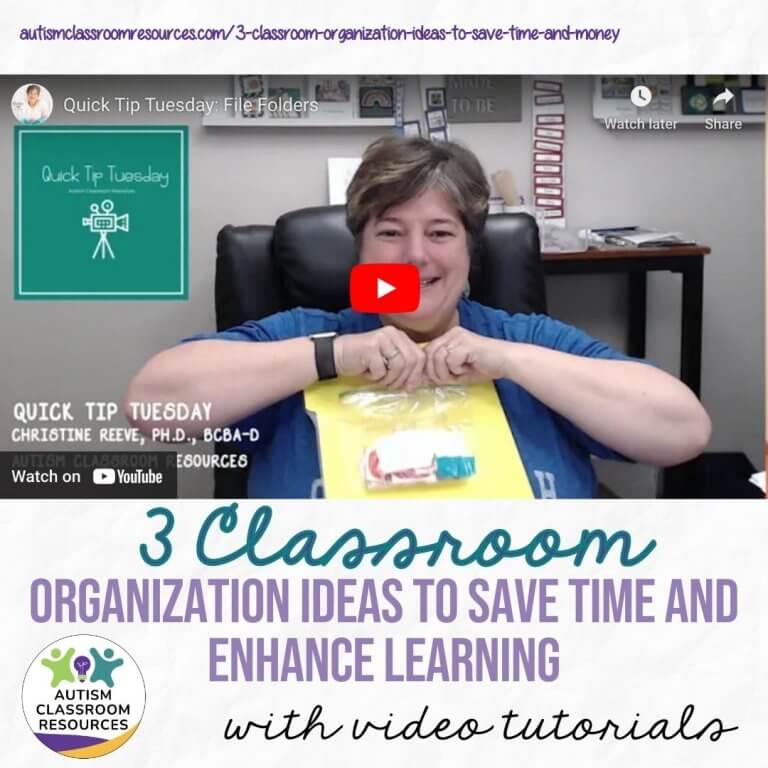Sharing is caring!
To see the rest of the list so far, click here.
That brings us to #7 in our list of 12! Entry number 7 is….curriculum. This has changed a bit in the last few years with NCLB, but a few years ago I would ask training audiences what curriculum they were using. Many of them would tell me that the IEP was their curriculum. Others couldn’t tell me what their curriculum was. The main point of this post is to talk about the role of curriculum in the classroom. The IEP is the individualized education program…it’s NOT the curriculum. A curriculum is a scope and sequence that tells you what to teach based on previous skills mastered. It is typically norm based in some way and based on a scaffolding of skills. The IEP may contain elements of the curriculum, but generally the curriculum is broader than the IEP and is taught in addition to the individual goals set for the student. With NCLB, students are now required to make progress on the general education curriculum. For students with complex educational needs, the curriculum is usually alternative or extended standards or a modification of the general standards. For higher functioning students they typically are working on the general education curriculum with accommodations that don’t change the content of the objectives but change the way they are presented. There are typically lots of different curricula used for individual subjects like reading and math. However, I want to focus more on general curricula that are often used for students on the spectrum that can be used to teach more general skills.
1.
The Unique Learning System. I have written
a number of posts about the Unique and mentioned it in others. What I really like about the Unique is that it is designed for the more complex learners and has the differentiation of the skills built in. It also has regular assessments of the content and the standards and is based on the common core curriculum, so it fits well with the requirements to work on the general education curriculum. The materials are already designed and for a full-year curricula and the amount of materials you get for it, it’s remarkably inexpensive. You don’t have to create visual supports for the materials, as they are already built in. It is a lot of printing, so
see yesterday’s post about printers and ink for ideas about how to support it. The Unique is great for classes that have a variety of children with disabilities and is not specific to autism. One of the other things I love about the Unique is that the materials are designed to be age-appropriate while also being developmentally appropriate. So for high school students who are functioning significantly below grade level, the materials are not “kiddie” materials but feature pictures and activities that are appropriate for their chronological age. It also spans the grades from preschool to transition out of high school.
2.
Strategies for Teaching Based on Autism Research (STAR). The STAR is a great curricula that combines the use of a curriculum-based assessment that is designed specifically for autism with evidence-based practice. It uses discrete trial teaching, Pivotal Response Training, and functional routines (task analysis) to teach skills across the domains. The Baudhuin Preschool at Nova Southeastern University, where I used to work, and many preschools I have worked with, use this program. The exceptional feature about it is that the curriculum-based assessment is directly linked to the teaching strategy and program to teach the skill. The kits are a little expensive but can be used repeatedly and come with materials to implement the programs. I use a different data collection system that my clients and staff are used to using and just adapt it to the program. You get an ongoing assessment throughout the year that is tailored to children with autism. It’s good for children preschool through early elementary / primary grades. If you have a higher functioning student, you are going to need additional academic curricula to supplement after preschool though. Overall it’s a great program that solves the problem of trying to determine a scope and sequence that is suitable for students with autism. For the language development in particular it’s really more helpful than other typical preschool curricula since it focuses on teaching some basic learning readiness skills that are not included in the others. It also is fairly brief to administer in comparison to other developmental checklists. I frequently recommend using the STAR and the Unique together to meet the general education standards and the autism needs, but the STAR is
mapped to the core curriculum. I typically implement the STAR differently than they suggest in their training with the strategies mapped across the day rather than focusing on the discrete trial sections for concentrated parts of the day. Overall it’s an extremely useful tool for an autism classroom. You can
request a preview DVD on their site as well.
3.
LINKS Curriculum. This curriculum is designed by the same company that created the STAR to extend the appropriate range to late elementary school through high school. It focuses on functional skills and provides task analyses for a variety of jobs and routines. It is available online and you have to purchase a license for each student you wish to use it for, which can be expensive as a yearly expense for a classroom. I have played with it some but have had difficulty getting a good picture of the curriculum-based assessment component of it that I love so much in the STAR. I can’t decide if this is because I’m so used to the paper-and-pencil format of the STAR or if you are expected to choose routines and skills that are needed by the student without a specific scope and sequence outside of selecting routines to that are needed. However it does use the same 3 strategies that the STAR uses so the transition as the child ages is fairly straightforward in that respect. For IEP planning that’s a great system, but it’s not as easy to use as a curriculum in that way. It also has some visuals to support some routines and an assessment system online. As with the STAR, it is
mapped to the common core curriculum and you can
check out a preview of it on their site. There are not very many functional skills curricula out there so it’s good tool to look at as a fit for your classroom.
4.
The Assessment of Basic Language and Learning System-Revised (ABLLS-R). This is the go-to curriculum for many behavior analysts working with children with autism who are using the Verbal Behavior approach. The ABLLS is very detailed and is a scaffolding of skills across a variety of domains including language as well as math, nonverbal, and other areas. The ABLLS-R gives a grid that is added to as the student progresses so the progress he or she makes is very visible. The progression it uses is developmental while also focusing on the use of communication and language in a functional manner. It can be completed with paper-and-pencil or there is an online version. The ABLLS is designed to be used for young children up to the age of about 6 years old. Using it with older students may be useful for the language components but mastering every skill on the ABLLS-R means that the developmental level is approximately at 6 years old, but doesn’t mean that the student can complete a variety of functional skills you would expect of a high school student. So, keep this in mind if you are working with middle and high school students.
5.
The Verbal Behavior Milestones Assessment and Placement Program (VB-MAP). The VB-MAPP is another Verbal Behavior tool that was developed more recently than the ABLLS, although close in the time to the ABLLS-R. It includes the use of augmentative communication strategies like the Picture Exchange Communication System (PECS) that is not included in the ABLLS specifically. It also is designed for younger children with language milestones going up to 4 years old, but the program notes that it can be used to assess the language skills of older individuals who have significantly delayed language skills. However, note that you are going to need something for other functional skills. There is a paper-and-pencil version, and online version and there is now an app available for use.
Regardless of the curriculum you use, keep the following thoughts in mind when choosing and using them.
- Make sure that the curriculum assessment, particularly the initial assessment, is done through observation and not by caregiver report. If caregiver report is all that is available, try to elicit and observe the behaviors yourself to assess the accuracy. One of the things that I like about the Unique is that the student actually completes the assessment and some of them can be done by the student on the computer.
- Make sure to re-administer or update them about 3-4 times per year to assess students’ progress. However, this shouldn’t take the place of regular data collection on the skills being taught.
- Make sure that the curriculum you are using meets both the needs and the age of the students you are working with. There are few functional curricula out there that are complete curricula. I’ve had some initial experience with the LINKS noted above. Jim Partington, who developed the ABLLS-R, and Michael Mueller have developed a functional curriculum assessment. I’ve looked at it but not extensively, so it might be worth checking out. It’s called the Assessment of Functional Living Skills (AFLS) and you can see samples on their website.
So, what curricula do you use in addition to adaptations of the core curricula? I would love to know what you think of the ones I’ve listed and others I haven’t reviewed as much. Please sound off in the comments.









